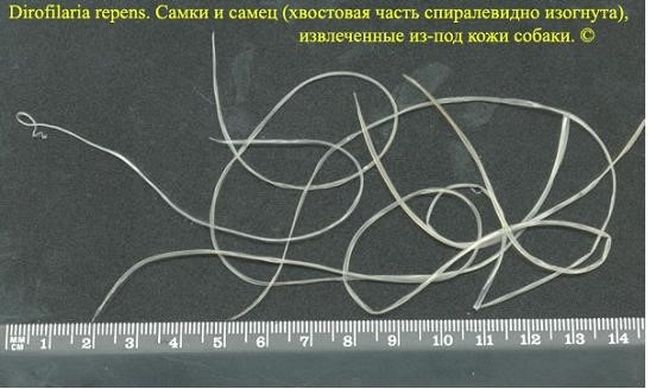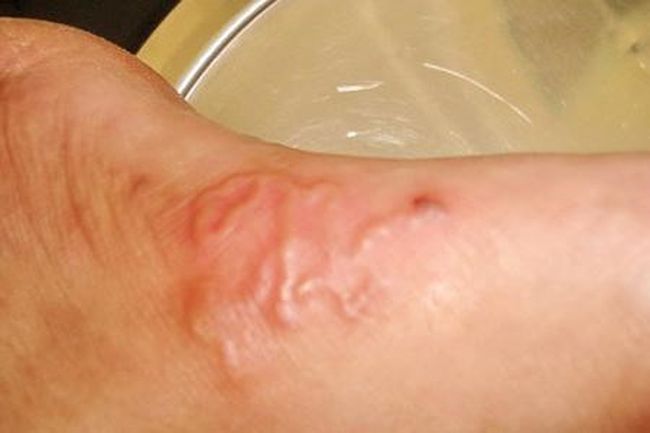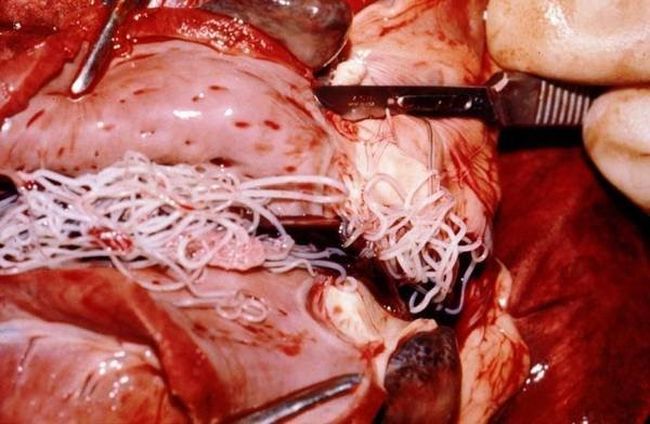Dirofilyarioz - a disease, caused by parasitic worms. Dirofilariasis in humans are often, as its carriers are dogs and cats, which many in the cities and other settlements. This disease - common in warm countries with mild climates, but in our latitudes, they became "settle down". Dirofilariasis not fatal and can be cured, if it does not run, so it is very important to know the symptoms of the disease, in time to begin treatment.

What causes a person dirofilariasis
The disease causes a long, thin parasitic worm Dirofilaria immitis and Dirofilaria repens. Translated from the Latin language its name means "evil thread". The parasite is really like a white thread, its length varies depending on the type and age of the 13 to 30 cm, and a thickness - up 1.2 mm. The ultimate owners of the worm are felines, civet and dog, but man is the intermediate host, in the body which invasive larva grows and lives, but it does not reach sexual maturity. Carry this parasite by mosquitoes, biting the infected animal, and then - man. In the bloodstream of the animal eggs are Dirofilaria, which fall to the mosquito. The larva begins to develop in the body of an insect, and quickly finds himself a new "home" if it enters the human blood.
In our latitudes occurs Dirofilaria, who lives under the human skin, in southern countries is more common parasite, It affects the internal organs. Subcutaneous worm easier to detect and remove, while internal parasite symptoms may not appear for a long time.
disease symptoms
After being bitten by an infected insect larvae and getting into human blood prior to the development of the parasite may go through a period of 1 month to one year. The first symptom - a swelling under the skin, the appearance of redness and itching. When this swelling can be either absolute painless, and cause severe discomfort. In appearance, the parasite under the skin (special, if the skin is tight) It recalls recently appeared abscess without rod, but its main difference is moving. The larva are actively moving and per day is able to crawl under the skin 15 centimeters. Sometimes the parasite is stationary, and tumor formed around it, resembling a lipoma, atheroma or fibroids. At the same time people go to the doctor, the surgeon opens the tumor and to everyone's surprise, finds a worm.

Dirofilaria distinguish sleeping from a simple abscess can be on location. Lipomas are often formed in those places, where the skin is thick and oily, and parasites prefer a place with a good circulation and thin skin.
- Eyes: eyeball, eyelids, skin around the eyes. Recognize the parasite is usually easy, its outline is clearly traced below the skin or mucous membranes.
- Face. Usually, the first becomes noticeable redness, then clearly outlines of the worm.
- Scrotum. Similarly, the above-described case.
- Trunk and neck.
- Arms.
- Mammary gland.
- Legs. In all these cases the worm may not be visible, but there is a strong redness and swelling of the place, Where is he located.
In addition to these obvious signs often observed in patients with dizziness, fast fatiguability, drowsiness, nausea. In finding the location of the parasite may occur severe pain or numbness appear tissues due to dying nerve endings.

Symptoms of ocular difilyarioza
More often (more, than half the) helminth settles in eyes. When it is not visible, the main symptom is the sensation of a foreign body in the eye, lacrimation, ptosis century, redness of the skin around the eyes, hack pain. In orbit around the worm is formed granuloma, which causes severe pain and inflammation. sometimes felt, the parasite moves, possible deterioration of vision.
Many patients in the treatment of an abscess under the skin, without knowing, it helminth, They are beginning to use a hot compress, What causes the worm migration. Sometimes he can "sleep" for a long period, and then stir and rise again.
Delays in access to a doctor can lead to an abscess or loss of vision, if the parasite lodged in the eye.
Symptoms of visceral dirofiljarioza
This form of the disease in our latitudes, is rare, but still it happens. She usually affects people, visit the southern countries. Invasive blood larvae entered into the heart of man, and then - to the lungs, which creates a fibrous capsule. For a long time the person can not disturb her presence, but sometimes there is a cough, chest pain, coughing up blood may. Capsules are detected on x-ray, reaching diameter 1-2 cm, often mistaken for cancer growths.
Diagnostics
determine, that the person is sick it dirofiljarioza only when removing helminth and its detailed examination under the microscope. As an auxiliary method of using a blood test ELISA. A patient man often heartworm larvae are antibodies, but the presence of antibodies in itself is not a guarantee, that the human body is Dirofilaria.
Imaging to determine the presence of a foreign object in the body. The larva is usually displayed as a small oval object or veretenopodobny, which is often confused with a cyst or neoplasm. Also larva visible on ultrasound. In visceral dirofiljarioza diagnose the disease can be extremely rare, usually the cause of aches and pains is opened during surgery.
Eosinophilia when blood test usually helps diagnose the presence of the majority of the parasites in the human body, but heartworm is observed only in the 10% cases, therefore can not be used to diagnose disease.
Treatment
heartworm treatment consists of removing the parasite from the human body. If the worm under the skin, anesthetize the skin surface, They make an incision and remove Dirofilaria. After that, the patient takes a while antihistamines. In those cases,, when there was inflammation using local antimicrobials and antibiotics are appointed. subcutaneous heartworm treatment takes place on an outpatient basis unless, When the larva is in the eye.

sometimes the doctor, to immobilize the parasite, It uses ditrazin. If, however, the parasite migrates constantly, It is located in a remote place or has the potential to damage the eyesight of an infected person, used drugs, kill parasites. Usually this means, comprising albendazole (eg, medizol or Worm).
If the worm is in the internal organs (lungs or heart), then it should be removed only by surgery. Admission antiparasitic agents may exacerbate the situation: dead larvae can become a foreign thrombus, once in the bloodstream, especially dangerous, If the worm is in the heart.
Typically, the subsequent treatment after removal of the parasite and removing the inflammation is not necessary, antiparasitic agents, too, as the larva does not multiply in the human body.
Prevention of heartworm
Statistics show, that cases of heartworm infection most often in the summer and spring. This is due to the fact, that is exacerbated by the flow of the disease in cats and dogs in the warmer months. studies say, As for 30% street animals have the disease and are dangerous to humans, if there are mosquitoes.

Prevention is:
- mosquito destruction;
- treatment of sick animals;
- prevention of contact with insects, animals and humans.
The main cluster of mosquitoes are found near bodies of water in the summer evening, Therefore, in such places it is necessary to use special insect repellent or wear clothes, that the insect can not bite through. Animals also need to wear collars, protect against insects and to prevent drinking water from reservoir.
In apartment buildings, especially older, Mosquitoes sometimes live all year round, getting into the apartment through the sewers. They breed in the basements with high humidity. This problem is solved by replacing pipes. If you have a similar problem, requesting repairs and housing office, as the mosquitoes in the house - it's not only unpleasant, but also dangerous.
Launched dirofilariasis in animals is difficult to treat, as the parasites in the heart (more often), dying, can lead to occlusion of blood vessels and valves, especially if the lesion was massive. To avoid the spread of the disease must be periodically (usually once every six months) give the cat or dog anthelmintic and anti-parasitic drugs.
Signs of heartworm in animals is:
- disruption of the skin surface;
- itch, baldness;
- lethargy, indifference;
- dyspnea, cough;
- fast fatiguability, rejection of games;
- hromota, convulsions.
If there were a few of these symptoms, you must immediately contact your veterinarian. This disease is treatable.
Important to remember, that the sick animal is not contagious to humans, so no need to isolate your sick pet or get rid of it.












